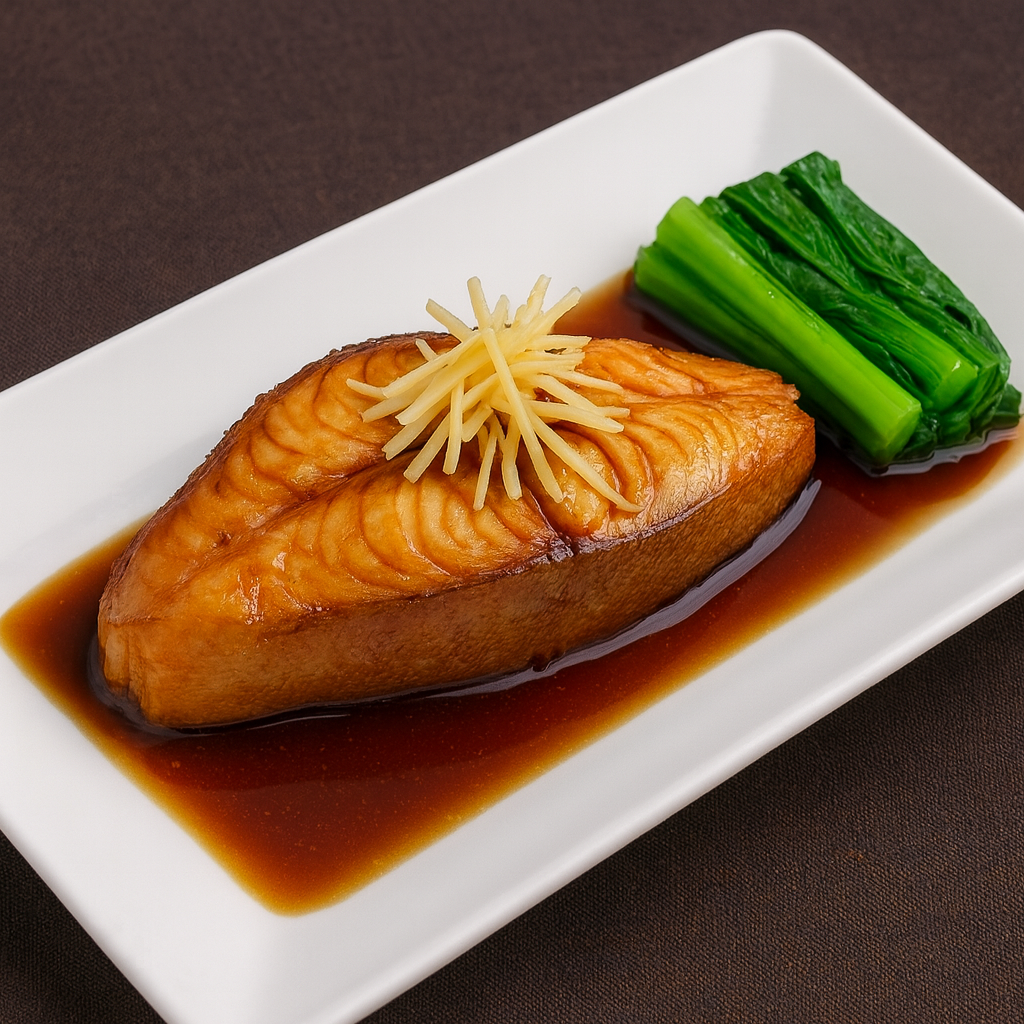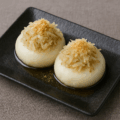ナメタガレイ(宮城)の特徴
冬のごちそう、正月の甘煮で親しまれます
宮城ではナメタガレイは冬に旨みが増し、正月の食卓を飾る「甘煮(煮付け)」として広く親しまれています。身はしっとりとして骨離れがよく、皮と腹まわりのゼラチン質が煮汁をまとって、つやとコクを生み出します。
ぬめりを落として上品な香りに
表面のぬめりは塩をふってから熱湯を回しかけ、冷水に取って洗うとすっきり取れます。生姜を合わせることで海の香りが引き立ち、仙台のねぎを添えると香味の相性がよく仕上がります。
ナメタガレイ(宮城) レシピ
材料 2人分
- ナメタガレイ 切り身(骨付き) … 2切れ(計300〜360g)
- 濃口しょうゆ … 大さじ2
- みりん … 大さじ2
- 酒 … 大さじ2
- 砂糖 … 大さじ1〜1.5
- 水 … 150ml
- 生姜(薄切り) … 6〜8枚
- 長ねぎ(ぶつ切り/仙台曲がりねぎなど) … 1本
- 下処理用:塩 … 少々
- 下処理用:熱湯 … 適量
作り方
- 切り身に塩を軽くふり、5分おいて水気を拭く。
- 皮目に熱湯を回しかけて霜降りにし、冷水に取ってぬめり・血合いを洗い、しっかり拭く。
- 鍋に水・酒・みりん・砂糖・しょうゆを入れて煮立てる。
- 皮を上にして切り身を並べ、生姜と長ねぎを加える。
- 落とし蓋をして中火で煮る。鍋を時々ゆすり、煮汁をかけながら7〜10分煮る。
- 落とし蓋を外し、弱めの中火で煮詰めて照りを出す。
- 火を止めて5〜10分おき、余熱で味を含ませる。
- 器に盛り、煮汁をかけて仕上げる。
シェフのワンポイントアドバイス
- 「塩→熱湯→冷水→拭く」の順で下処理をすると、ぬめりと臭みがしっかり取れます。
- 皮目を上にして煮ると煮崩れしにくく、つやが均一に出ます。
- 宮城の甘煮はやや甘口が定番です。砂糖量で甘さを調整し、仕上げに少量のしょうゆを追うと味が締まります。
- 子持ちの時季は沸騰を抑え、鍋をやさしく揺らす程度にすると卵が割れにくいです。
栄養価(1人分の目安)
- エネルギー … 約240kcal
- たんぱく質 … 約24g
- 脂質 … 約8g
- 炭水化物 … 約12g
- 食塩相当量 … 約2.5g
- 特徴成分 … DHA・EPAを含みます
歴史
宮城の冬の味として定着
三陸沖で水揚げされるナメタガレイは、宮城の冬を代表する魚として家庭の煮付けに受け継がれてきました。脂がのる寒の時季は特に人気が高いです。
正月のごちそう「甘煮」
年末に買い求め、正月に甘辛く煮付ける習わしが広がりました。つやのある煮汁とほろりとした身が祝いの席に好まれます。
呼び名と扱いの地域差
市場や地域によって呼び名や扱いに幅があり、「ナメタ」「ナメタガレイ」と総称されることがあります。宮城では煮付け向きの魚として定番化し、家庭の味として根づいています。
English Version
Nameta-garei (Miyagi) — Features
A winter delicacy, beloved as a New Year’s “sweet-simmered” dish
In Miyagi, Nameta-garei (slime flounder) is prized in winter when its flavor deepens. The flesh turns tender with clean bone-off, while the gelatin around the skin and belly coats the fish with a glossy, flavorful glaze when simmered.
Clean off the slime for a refined aroma
Sprinkle salt, then pour hot water over the skin and rinse in cold water to remove slime and odor. Fresh ginger lifts the ocean aroma, and adding Sendai long green onion complements the savory-sweet sauce.
Nameta-garei (Miyagi) Recipe
Ingredients (Serves 2)
- Bone-in Nameta-garei fillets … 2 pieces (total 300–360 g)
- Soy sauce (koikuchi) … 2 Tbsp
- Mirin … 2 Tbsp
- Sake … 2 Tbsp
- Sugar … 1–1.5 Tbsp
- Water … 150 ml
- Ginger, thinly sliced … 6–8 slices
- Long green onion (e.g., Sendai “Magari-negi”), cut into chunks … 1 stalk
- For prepping: salt … a pinch
- For prepping: hot water … as needed
Directions
- Lightly salt the fillets; rest 5 minutes, then pat dry.
- Pour hot water over the skin to blanch; transfer to cold water, gently remove slime and blood, and dry well.
- Bring water, sake, mirin, sugar, and soy sauce to a boil in a pan.
- Set the fillets skin-side up; add ginger and green onion.
- Cover with a drop-lid and simmer over medium heat, occasionally shaking the pan and basting for 7–10 minutes.
- Remove the lid and gently reduce over medium-low heat to a glossy finish.
- Turn off the heat and let stand 5–10 minutes to absorb flavor; plate and spoon over the sauce.
Chef’s Tips
- Follow the sequence “salt → hot water → cold water → pat dry” for clean flavor and sheen.
- Simmer skin-side up to prevent breakage and to achieve an even glaze.
- Miyagi’s style leans slightly sweet; adjust sugar to taste, and a final dash of soy sauce tightens the finish.
- When roe is present, avoid a rolling boil—gently shake the pan so the eggs stay intact.
Nutrition (per serving, approx.)
- Energy … ~240 kcal
- Protein … ~24 g
- Fat … ~8 g
- Carbohydrates … ~12 g
- Salt equivalent … ~2.5 g
- Notable nutrients … DHA & EPA
History
A settled winter taste of Miyagi
Landed off the Sanriku coast, Nameta-garei has long been enjoyed in Miyagi as a winter staple, especially prized when the fish fattens in the cold season.
New Year’s celebratory “sweet simmer”
Families traditionally purchase the fish at year’s end and simmer it sweet-savory for the New Year table. Its glossy sauce and tender flakes suit festive meals.
Regional names and handling
Names vary by market and region (“Nameta,” “Nameta-garei”), but in Miyagi it is firmly established as a go-to fish for simmered dishes in home cooking.



何でも質問してください!